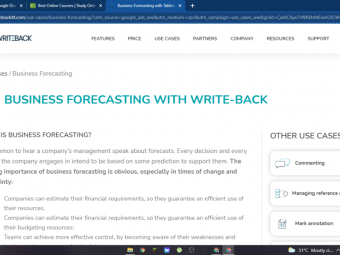Pmi Acp Certification Agile Project Management Essentials
Tags: PMI-ACP
Agile Certified Practitioner Certification Program (PMI-ACP) - Course 1 of 8 - Agile Project Management Essentials
Last updated 2022-01-10 | 4.4
- understand characteristics of agile project management- distinguish between primary and secondary agile values
- recognize agile principles
- recognize the differences between defined and empirical methodologies
- and compare the agile triangle of constraints with that of traditional project management.
- compare the phases of traditional project management with those of the agile framework
- understand how a project manager's responsibilities will change on an agile project
- and distinguish between common agile methodologies.
What you'll learn
* Requirements
* general knowledge regarding project management is a plus but not necessary.Description
Welcome to the Agile Project Management Essentials course. This is the first course of a series of eight that will form the Agile Project Management - The PMI-ACP (Agile Certified Practitioner) Certification Program.
Why Agile Project Management?
Agile projects are characterized by the use of short work iterations and incremental development of products, made possible by focusing on business priorities and customer value. The course provides an introduction to common agile methodologies, describes the relationship between defined and empirical processes, and highlights the key difference in regard to the triangle of constraints of agile versus traditional methods.
Guidance on how to take steps towards adopting an agile project management approach for those who currently use a traditional, plan-driven methodology is included. The relevant section discusses some common myths and misconceptions about agile development approaches, identifies factors to consider when deciding whether to adopt agile practices, and explains the general agile practices that a company may want to adopt.
Who is your instructor?
My name is Sorin, and I will be your instructor. I am a trainer and project manager with more than 10 years of experience. Before Udemy, I trained hundreds of people in a classroom environment – civil servants, managers, project workers, aid workers and many more. And I managed projects in the fields of justice, corrections, regional development and human resources development.
How will you benefit?
And, this course is intended for project managers, program managers, or anyone who wants to efficiently participate in agile projects. It is aligned with the Agile Certified Practitioner exam objectives developed by the Project Management Institute® and Certified ScrumMaster learning objectives.
The course includes training videos, examples, exercices and quizes. And, if you take your time to go through all the learning materials this will entitle you to claim 5 PDU’s for the PMI certification exams and to maintain your PMI certification.
So, thank you for condidering this course! Now, go ahead, and hit that "Take This Course" button. And, see you on the inside.
Who this course is for:
- intended for project managers, program managers, or anyone who wants to efficiently participate in agile projects.
- aligned with the Agile Certified Practitioner exam objectives developed by the Project Management Institute® and Certified ScrumMaster learning objectives
- will entitle you to claim 5 PDU’s for the PMI certification exams and to maintain your PMI certification
Course content
5 sections • 47 lectures
Course Overview Preview 02:27
If you have followed a traditional project management approach and find yourself spending a lot of time fine tuning the design to accommodate changing requirements, you may want to consider a different approach. In this course, you will be introduced to agile project management, including the core values and principles outlined by the Agile Manifesto.
Program Overview Preview 08:51
This video will help you understand better the content of the other courses that will form this Agile Project Management - The PMI-ACP (Agile Certified Practitioner) Certification Program.
SECTION 1 - Agile Project Management Essentials Preview 02:17
Just to be clear, because what I call section in the larger Certification Program, is a course by itself, let’s see what this course includes.
The Agile Project Management Essentials course will have two parts. And, the first one will be on what is called The Agile Approach.
Course Guidelines Preview 03:17
You might know this. I’m adding it to any course in the introductory section. But, just in case some suggestions to improve your learning.
Introduction to the course
Understand structure, content and udemy for a better learning experience.
Agile Manifesto and Agile Principles Preview 00:01
Agile Manifesto and Agile Principles
Defining Agile project management Preview 02:09
This lesson will be very short and very clear. You are going to learn here what Agile project management means. This we can call the starting point, and with this we begin our course on Agile Project Management Essentials. And, please don’t expect more than the essentials in this course, the other courses that form the mentioned Certification Program will come with the rest of the information.
Predictive, iterative, incremental and agile project life-cycles Preview 00:40
Predictive, iterative, incremental and agile project life-cycles
Agile characteristics Preview 10:13
Agile project management has several key characteristics:
- it relies on cross-functional teams that work in short iterations, and
- uses an incremental approach to development;
- it also focuses on business priorities and customer value, and
- strives for continuous improvement.
Individuals and Interactions versus Processes and Tools Preview 00:11
Individuals and Interactions versus Processes and Tools
Benefits of agile management Preview 08:31
Benefits of agile project management in relation to more traditional management approaches are that it can:
- reduce risk,
- speed up delivery,
- generate more value, and
- reduce the cost of making changes.
The relationship between Agile Manifesto, Values, Principles and Common Practice Preview 00:03
The relationship between Agile Manifesto, Values, Principles and Common Practices
Primary and secondary Agile values Preview 06:48
In 2001, representatives of different agile software development methodologies met to promote the development of the agile approach. They called themselves the Agile Alliance and drafted the Agile Manifesto which outlines basic values for agile development. In turn, these values are underpinned by specific principles.
The authors of the Agile Manifesto are Kent Beck, Mike Beedle, Arie van Bennekum, Alistair Cockburn, Ward Cunningham, Martin Fowler, James Grenning, Jim Highsmith, Andrew Hunt, Ron Jeffries, Jon Kern, Brian Marick, Robert C. Martin, Steve Mellor, Ken Schwaber, Jeff Sutherland, and Dave Thomas.
Why agile values are important Preview 00:02
Why agile values are important
Agile principles Preview 14:13
Twelve agile principles describe the four agile values in more detail. The first six principles are:
- to focus on satisfying the customer
- welcoming change
- delivering working software frequently
- ensuring that business people and developers work together
- motivating the individuals involved in development, and
- using face-to-face communication whenever possible
Traditional project opportunity for change Preview 00:08
Traditional project opportunity for change
The evolution of Agile models Preview 02:39
A development model is a guide to the development process, to help ensure that no important aspects of development are overlooked. Traditionally, development models were highly defined and linear. The trend now is toward more empirical models that include iterative and incremental processes, to provide greater flexibility.
Defined and empirical models Preview 09:03
The waterfall (also known as traditional) model divides the development process into five phases:
- Requirements
- Design
- Development
- Testing
- Deployment
The role of the project plan Preview 05:29
Traditionally, a project plan is a document that helps project managers execute and control the phases of a project. It clarifies a project's objectives and how they can be achieved. Information included in a project plan typically includes the project's scope, cost, and schedule, as well as its activities, deliverables, milestones, and resources.
Inspection and adjustment Preview 05:22
Highly defined and empirical development methods also differ in their approaches to product inspection, and to the adjustments required in response to customers' reviews of deliverables. Consider the differences between two teams that are developing a cell phone service, each using a different model.
The Agile triangle of constraints Preview 07:36
The traditional iron triangle of constraints identifies three main types of constraints on the success of a project - scope, cost, and schedule. Change to any one of these constraints will affect the others. The quality of a project depends on satisfying all three constraints.
The Agile Approach
After completing this section, you will be able to: understand characteristics of agile project management, distinguish between primary and secondary agile values, recognize agile principles...
Agile History Preview 00:12
Agile History
Traditional and Agile approaches Preview 06:49
Based on the Agile Project Management model derived by Jim Highsmith, agile project management can be divided into five phases:
- Envisioning
- Speculating
- Exploring
- Adapting, and
- Closing.
Agile vs Traditional project management Preview 00:05
Agile vs Traditional project management
Traditional and Agile project phases Preview 09:22
Like the agile approach, traditional project management can be described in terms of five key phases. These are:
- Initiating,
- Planning
- Executing
- Monitoring and Controlling, and
- Closing.
Each of these differs in specific ways from the corresponding agile phase.
Agile project management Preview 14:46
Agile development avoids the prescriptive, plan-oriented approach associated with traditional project management, and makes use of self-organizing teams. However, it is a common misconception that agile projects don't require project management.
Project management is still necessary. But, the traditional responsibilities of the project manager may be handled differently and possibly be spread out across members of the agile project team.
Scrum, XP, and Lean Preview 13:25
You can implement agile project management using different methodologies. Although every agile methodology has different characteristics, they all maintain essential agile principles. Three widely used agile methodologies are:
- Scrum
- Extreme Programming - also known as XP, and
- Lean development
Other Agile methodologies Preview 06:27
Other agile methodologies include the Crystal family of methodologies, Feature Driven Development, or FDD, Dynamic Systems Development Method - or DSDM - as well as Adaptive Software Development - also known as ASD. The methodology you choose should depend on what will best suit a particular project.
Agile Models and Methodologies
After completing this section, you will be able to: compare the phases of traditional project management with those of the agile framework, understand how a project manager's responsibilities ...
Course Project (Optional) Preview 00:31
Course project (optional)
Agile Project Management Essentials Preview 02:21
Congratulations! You finished the The Agile Project Management Essentials course!
After completing the first part of the course - called The Agile Approach -, you are now able to:
- understand the characteristics of agile project management, and why is this important;
- distinguish between primary and secondary agile values, and how this might help you in your work;
- recognize and apply agile principles in your projects;
- recognize and use the differences between defined and empirical methodologies; and
- compare the agile triangle of constraints with that of traditional project management.
PMI-ACP Certification: Agile Project Management Essentials
Course wrap-up and conclusions.
Section Overview Preview 02:10
This course covers the key exam concepts of Kanban, work in progress or WIP, lead time, cycle time, and Little's Law. You'll also learn about Agile Team Spaces, sharing the product vision, and identifying and reducing defects.
Waste Types Preview 05:51
In Lean project management waste, or the Japanese term Muda, is defined as any activity or process that doesn't add value to a product but does add cost. Lean's original Seven Forms of Waste include transportation, inventory, motion, waiting, overprocessing, overproduction, and defects. The new eighth form of waste is skills or non-utilized talent.
The Kanban Pull System Preview 06:14
In a Pull-based system, the customer demand creates what is called pull. Production or development relies on pull rather than on complicated market forecast to determine how many products to deliver.
Kanban Boards Preview 05:36
A Kanban board is a tool that agile teams often use to visualize workflow through a system. While Kanban principles are often used in IT and software development, they can be helpful in any industry.
Determining Lead Time and Cycle Time Preview 05:59
In lean project management, one of the key concepts is process improvement. Lead time and cycle time are two important metrics that help determine how lean a process is. In other words, how much of the time dedicated to creating a product is value added.
Process Cycle Efficiency Preview 06:53
Lean manufacturing is a management philosophy that focuses on reducing waste and implementing a flow-based production line rather than a batch and queue method. It's aimed at reducing costs and improving overall customer value.
Little's Law Preview 07:17
In order to maintain a stable process with minimal chaos organizations should attempt to minimize work in progress or WIP in their processes. One way to do this is by setting WIP limits. WIP limits help to reduce bottlenecks, improve the rate of throughput, and control the workload levels of project team members.
Communicating the Product Vision Preview 06:03
Stakeholder engagement is a fundamental part of project management. It's important to be able to express the product vision to stakeholders in order to gain support in common understanding about the product requirements. The product owner often collaborates with other key stakeholders to develop a product vision.
Defining the Agile Team's Physical Space Preview 06:01
With today's modern technology there are a variety of tools to bring teams together virtually.
Exercise - Key Agile Exam concepts Preview 05:09
Agile teams achieve efficiency by leveraging many of the tools from Lean Management, but also by valuing individuals and interactions.
In this exercise, you'll demonstrate that you can identify characteristics of waste recognize the relationship between PCE variables identify characteristics of Agile environments
Agile Key Exam Concepts Preview 01:52
This course covers the key exam concepts of Kanban, work in progress or WIP, lead time, cycle time, and Little's Law. You'll also learn about Agile Team Spaces, sharing the product vision, and identifying and reducing defects.
Agile Key Exam Concepts
This course covers the key exam concepts of Kanban, work in progress or WIP, lead time, cycle time, and Little's Law. You'll also learn about Agile Team Spaces, sharing the product vision, and identifying and reducing defects.
PMI Certification Info Preview 00:04
PMI Certification Info
Bonus Lecture Preview 00:05
More courses at discount prices.








 This course includes:
This course includes:
















